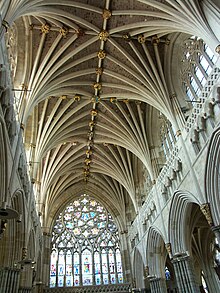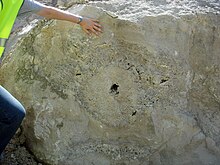Purbeck marble
As Purbeck Marble ( Engl. Purbeck Marble ) is a stone called, mainly on the Isle of Purbeck , a peninsula in the county of Dorset , on the south coast of England was recovered.
In the geological sense, it is a fossil-bearing limestone . Since this limestone can be polished well and its name has been handed down historically, the addition “ marble ” has been retained for this sedimentary rock , although it was not changed metamorphically . Purbeck marble is of great cultural and historical importance in England and was often used for church buildings in southern England.
Occurrence
Purbeck marble originated in the late Jurassic and early Cretaceous . The deposits formed in alternation of salt and fresh water in sea bays and fresh water zones ( lacustric ) about 146 to 141 million years ago (former Purbeck stage ). The geological structure of the Isle of Purbeck is very differentiated.
The stone obtained from the upper layers was called Purbeck Freestone (Laugton quarries) by the stone crushers and stonemasons and the lower layers were called Purbeck-Portland Stone . The Purbeck Cliff Stone came from the Seacombe quarries not far from Swanage . The alternative name Purbeck Stone is derived from this. The cut stones from the uppermost strata ( Upper Ostracod Clays and Shales Member ) of the former Purbeck formation were sometimes referred to separately as Purbeck Marble because of their special decoration . Zones with clay slate occur here.
Sediment formation in eastern Dorset began in the Upper Jurassic ( Tithonian ) period. Initially, clay was deposited on the bottom of the sea bays. This was followed by so-called Portland sand and the limestone layers of the Portland stage (currently part of the Tithonium) and the Purbeck stage (currently part of the Berriasium ). The layers of the earlier Purbeck stage contain fossilized remains of mussels, fish and reptiles. Fossil deposits in Purbeck marble consist of freshwater snails such as Viviparus (pond snails), Valvata , Lymnaea (mud snails), Planorbis ( plate snails ), Hydobia (common mud snails ), Physa (bladder snails), Melania , Cyclas and Unio .
The characteristic appearance of the Purbeck marble comes mainly from the fossilized shells of the freshwater snail Viviparus . These fossils are also mainly found in the English Sussex Marble , also known as Petworth marble or Winklestone . The banks of the limestone deposits of the Purbeck marble are strongly supported and separated by layers of clay and loam. This natural deposit situation facilitates its extraction in the quarry. This rock has a multicolored appearance from green, gray, blue, beige to brown.
Numerous traces of dinosaurs were found in the deposit of the Purbeck marble.
use
It is believed that Purbeck marble was used as early as the 1st century. In the time of the Romano-British it was used for building stones, as well as for slabs. But everyday items such as mortars and pestles were also made from it, and it was also dismantled for mortar production . Occasionally Purbeck marble is said to have been delivered to Normandy between the 4th and 11th centuries.
It is believed that this limestone was mainly processed at Corfe Castle in the 11th century and that the proximity to the coast contributed to the success of this stone. Later the production of the stone relocated to London for the construction of the numerous churches and Westminster.
Purbeck marble was used in many cathedrals in southern England in the Middle Ages , and was also used for columns and floor slabs. Around the 1880s, the church buildings in Kingston , Purbeck and Dorset were built from it. For restoration work in southern England, this natural stone was used in numerous and art-historically important church buildings, such as in Exeter , Ely , Norwich , Chichester , Lincoln , Landaff, Southwark and Westminster Abbey . In Salisbury Cathedral , the pillars, as well as their foundation plates and shafts, are made of Purbeck marble. Salisbury has more Purbeck marble than any other cathedral. The Cathedral of York is in the transepts and chapter house decorated with columns of Purbeck marble.
Purbeck marble is currently no longer actively mined, but blocks are occasionally extracted or stored rough stones are used for restoration measures as required. English stone sculptors prefer Purbeck marble because of its malleability.
See also
Web links
- Ian West: Swanage Bay and Ballard Cliff, Dorset with geological maps and profile of the mining region
- Geology of the Wessex Coast
- Portrait from Purbeck Marble
- Andrew R. Milner: The Turtles of the Purbeck Limestone Group of Dorset, Southern England (PDF; 1.1 MB)
- Fossils in Purbeck marble
literature
- John Watson: British an Foreign Building Stones. A Descriptive Catalog of the Specimens in the Sedgwick Museum, Cambridge . Cambridge University Press, Cambridge, 1911
- John Ashurst and Francis G. Dimes: Conservation of Building and Decorative Stones , Butterworth-Heinemann, London, 1990. ISBN 978-0-7506-3898-2 Online on Google Books
- HA Tummers: Early Secular Effigies in England, The Thirteenth Century (Leiden), 1980 Online on Google Books
continuing
- DF Williams: Purbeck marble in Roman and medieval Britain . In: David A. Hinton (Ed.): Purbeck Papers. Southampton (UK), University of Southampton, Department of Archeology, 2004, pp. 126-131. (Department of Archeology Monograph Series, 4)
Individual evidence
- ↑ Max Schvoerer, Norman Herz, Katherine A. Holbrow, Shelley Sturman: Archéomatériaux: marbres et autres roches: ASMOSIA IV, Bordeaux-Talence, 9-13 October 1995 . In: Max Schvoerer, Center de recherche en physique appliquée à l'archéologie (Ed.): Transactions of the ... international symposium of the Association for the Study of Marble and Other Stones used in Antiquity . tape 4 . Presses Univ de Bordeaux, 1999, ISBN 2-86781-244-5 , pp. 353–357 (French, limited preview in Google Book Search [accessed January 11, 2017]).
- ↑ John Watson: Building Stones , 1911, pp. 183, 314
- ^ Ian West: Purbeck Formation - Jurassic-Cretaceous. Section: The Members of the Purbeck Formation. Retrieved April 27, 2010
- ^ William Joscelyn Arkell: The gastropods of the Purbeck Beds, Quarterly Journal of the Geological Society; 1941; v. 97; issue.1-4; p. 79-128 , accessed March 30, 2010
- ↑ Stone surfaces and colors on purbeckstone.co.uk , accessed March 28, 2010
- ↑ Information on soton.ac.uk
- ↑ Grand Origins: Purbeck Stone, A History on stone.uk.com , accessed March 28, 2010
- ↑ John Beavis (1971): "The use of Purbeck Marble in Roman Britain", Proceedings of the Dorset Natural History and Archaeological Society , 92, 181-204
- ^ Peacock / William: p. 47
- ^ Tummers: Early Secular Effigies in England. P. 13 (see literature)
- ^ Peacock / Williams: p. 43
- ^ Peacock / Williams: p. 44
- ↑ Kingston (St. James Church) on people.bath.ac.uk ( memento of the original from November 21, 2007 in the Internet Archive ) Info: The archive link was inserted automatically and has not yet been checked. Please check the original and archive link according to the instructions and then remove this notice. , accessed March 28, 2010


